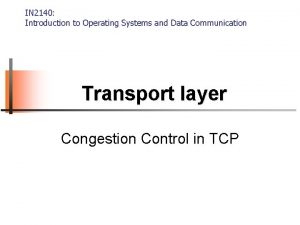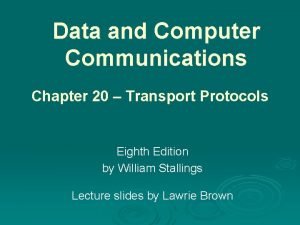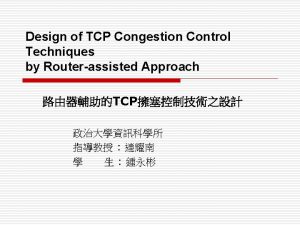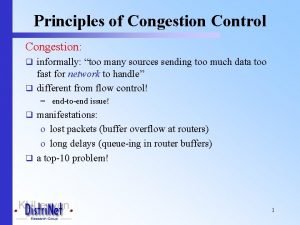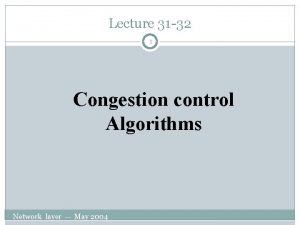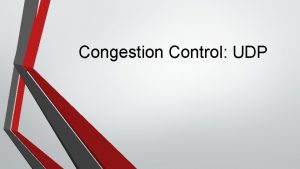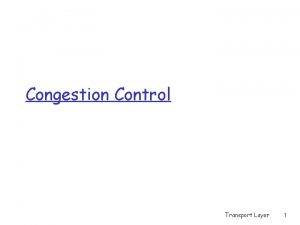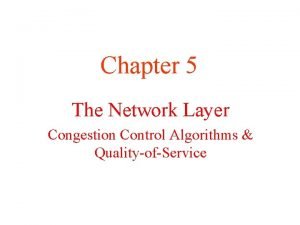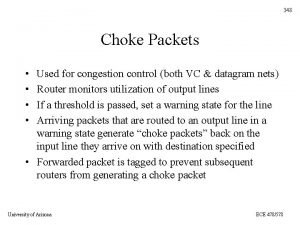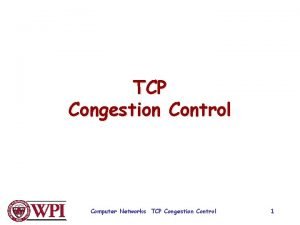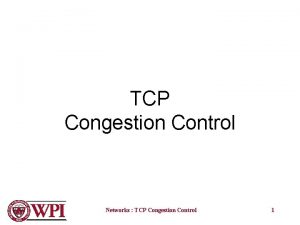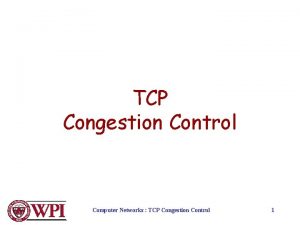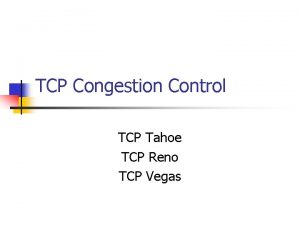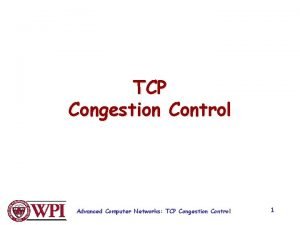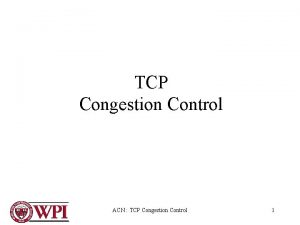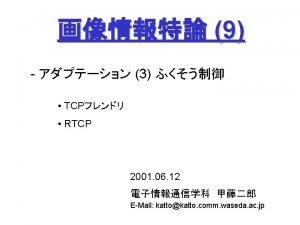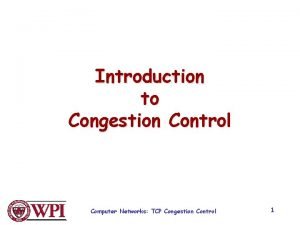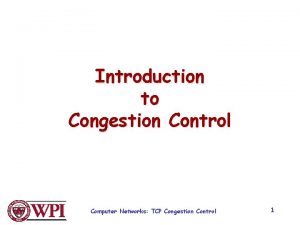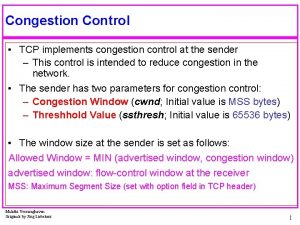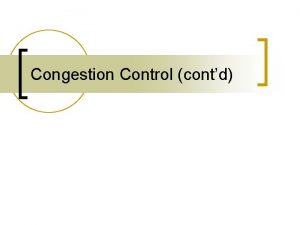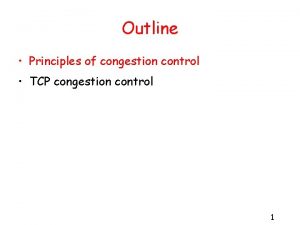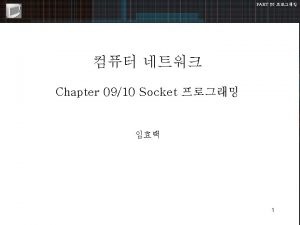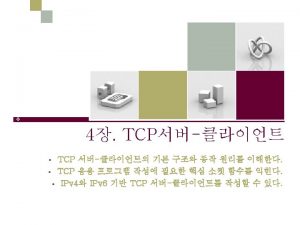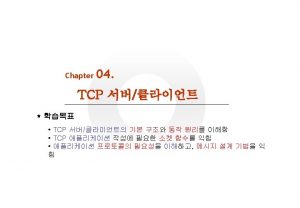Communication Networks Recitation 9 Fairness TCP Congestion Control



















- Slides: 19

Communication Networks Recitation 9 Fairness & TCP Congestion Control Comnet 2006 1

Max-Min Fairness • The intuition: to maximize the bandwidth allocated to the session with the minimum allocation • More formally: to maximize the allocation of each session i under constrain that an increase in i’s allocation doesn’t cause a decrease in some other session allocation with the same or smaller rate than i Comnet 2006 2

Example of max-min fair flow Session 2 Session 3 Session 1 Capacity=1 Session 0 Maximal fair flow division will be to give for the sessions 0, 1, 2 a flow rate of 1/3 and for the session 3 a flow rate of 2/3 Comnet 2006 3

TCP Overview • Connectionoriented • Byte-stream – – app writes bytes TCP sends segments – app reads bytes • Reliable data transfer • Full duplex • Flow control: keep sender from overrunning receiver • Congestion control: keep sender from overrunning network Comnet 2006 4

TCP Segment Structure 32 bits URG: urgent data (generally not used) ACK: ACK # valid PSH: push data now (generally not used) RST, SYN, FIN: connection management (reset, setup teardown commands) Also in UDP source port # dest port # sequence number acknowledgement number head not UA P R S F len used checksum rcvr window size ptr urgent data Options (variable length) counting by bytes of data (not segments!) # bytes rcvr willing to accept application data (variable length) Comnet 2006 5

Connection Establishment Active participant (client) Passive participant (server) SYN, Sequ ence. N um = x K AC + N Y S ACK, = y, m u nce. N e 1 u q =x + , Se t en m g d e wl o Ackno wledg ment Comnet 2006 =y+1 6

Connection Termination Active participant (server) Passive participant (client) FIN, S eque nce. N um = x x+1 = t n me g d e l y ow = n k m c u A nce. N e u q Se FIN, Ackno wledg ment =y + 1 Comnet 2006 7

Detecting Congestion • Packet drops indicate congestion – Is that really true? – Why does it work? Packet Dst Src Drop Ack Timeout! No Ack = Congestion! Comnet 2006 9

Controlling Congestion – The Effect of Window Size • Note that sender’s window is equal to the number of sender packets in flight (in the network). Window Source Destination A Window’s worth of pa ckets X acks X more p ack 2006 ets Comnet 10

Controlling Congestion • Reduce window less packets in the network • Increase window more packets in the network • Idea: Concept of a congestion window – window is smaller when congestion is larger and vice versa Comnet 2006 11

Additive Increase, Multiplicative Decrease • Each time a packet drop occurs, slash window size in half (multiplicative decrease) – Multiplicative decrease is necessary to avoid congestion • When no losses are observed, gradually increase window size (additive increase) Comnet 2006 12

Additive Increase Src D A D D A A D D D A A A Dest Comnet 2006 13

Leads to the TCP “sawtooth” Rate Timeouts halved Could take a long time to get started! Comnet 2006 t 14

“Slow Start” Designed to cold-start connection quickly at startup or if a connection has been halted (e. g. window dropped to zero, or window full, but ACK is lost). How it works: increase cwnd by 1 for each ACK received. Src 1 D 2 A D D 4 A A D D 8 D A A A Dest Comnet 2006 15

Slow Start Rate 3 Dupacks halved Exponential “slow start” Slow start in operation until it reaches half of t cwnd. previous Why is it called slow-start? Because TCP originally had no congestion control mechanism. The source would just start by sending a whole window’s worth of data. Comnet 2006 16

Fast Retransmit & Recovery • Upon 3 duplicate ACKs, TCP retransmits. • Do not enter slowstart. Sender Receiver Packet 1 Packet 2 Packet 3 ACK 1 Packet 4 ACK 2 Packet 5 ACK 2 Packet 6 ACK 2 Retransmit packet 3 ACK 6 Comnet 2006 17

TCP Vegas • Uses congestion avoidance instead of congestion control – Reno: Congestion control React to congestion after it occurs – Vegas: Congestion avoidance Predict and avoid congestion before it occurs Comnet 2006 19

Observation • Packet accumulation in the network can be inferred by monitoring RTT and sending rate cwnd Send ing R ate Overloaded Bottleneck Link Router Sending Rate = cwnd / RTT Comnet 2006 20

TCP Vegas Congestion Control • Base. RTT is the minimum of all measured RTTs (commonly the RTT of the first packet) • If not overflowing the connection, then Expect. Rate = Congestion. Window/Base. RTT • Source calculates Actual. Rate once per RTT • Source compares Actual. Rate with Expect. Rate Diff = Expected. Rate - Actual. Rate if Diff < a increase Congestion. Window linearly else if Diff > b decrease Congestion. Window linearly else leave Congestion. Window unchanged Comnet 2006 21
 Tcp congestion control
Tcp congestion control Tcp congestion control
Tcp congestion control Principles of congestion control
Principles of congestion control Tcp header length
Tcp header length Pincuegula
Pincuegula General principles of congestion control
General principles of congestion control Principles of congestion control
Principles of congestion control Traffic throttling and load shedding
Traffic throttling and load shedding What are the general principles of congestion control
What are the general principles of congestion control Congestion control in virtual circuit
Congestion control in virtual circuit Udp congestion control
Udp congestion control Principles of congestion control
Principles of congestion control Congestion control in network layer
Congestion control in network layer Choke packets
Choke packets General principles of congestion control
General principles of congestion control Passive recitation
Passive recitation Quood 8
Quood 8 Is the rote recitation of a memorized written message
Is the rote recitation of a memorized written message Objectives of poem recitation
Objectives of poem recitation Reciting a poem
Reciting a poem
